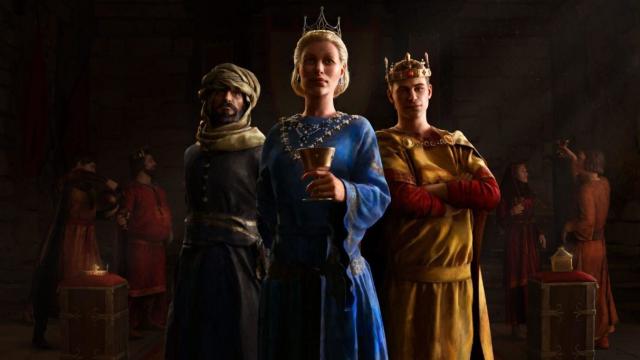I reviewed Crusader Kings III in August 2020 and was about as glowing as I have ever been about a video game here on Kotaku.com. Yet having previewed it, then played it to death for review, when I was done I put the game down and haven’t been back to it since.
That’s not a slight against the game, it’s just how I’ve learned to approach big Paradox releases over the last decades. From Hearts of Iron to Stellaris, these games tend to launch in a pretty decent state, then transform over the years via constant patches and expansions, and to best evaluate each game’s progress on that journey I’ve found that instead of just playing them all the time, I come back every year or two and see what’s up.
Which is exactly what I’ve done here, because Crusader Kings III just got its first major expansion, the Royal Court. This being the first time I’ve revisted the game since launch, and also its first big update, I figured this was a great chance to see how it was shaping up 18 months after release.
I don’t want to shock you here, but it is shaping up very nicely indeed. Royal Court is a weird expansion, at least by Paradox standards, because unlike most offerings from the company for its grand strategy releases, which tend to weave their way into existing systems, Royal Court stands purposefully apart from the primary Crusader Kings experience.
It does exactly what the name suggests and adds a literal Royal Court to the game, a screen you can visit at any time that’s separate to the maps and menus that previously constituted the entirety of the space within which a Crusader Kings campaign existed. Through it, your inner circle of children, councillors and courtiers are represented in the flesh; crowds gather and whisper, you’re seated in the centre of the room on your throne, and anyone addressing you will do so on bended knee.
This room isn’t a static object; the people who populate it will change over the years/centuries as they die/move away and are replaced, just like your player character, but the room itself also has space for artefacts, items that can be built or won and displayed like trophies. You can hang banners from the wall, or have swords threatening your guests from pedestals alongside you. The condition of your throne room soon becomes the physical representation of the health and personality of your realm itself.
It sounds like an utterly pointless exercise in vanity, but it’s not, because it’s not really a new idea. Something almost identical to this attempt at immersion could be found in early Civilisation games, which let you improve your palace or throne room, translating political power into aesthetic delights.
I LOVED that diversion, and loads of other fans did too, which is why people are still modding thrones rooms into modern Civilisation games today. And I loved it for the same reasons I love Royal Court. Crusader Kings is a game that exists at a grand scale, one that’s always represented on a distant map that spans half the globe. It’s a game about human relationships, which are only ever glimpsed through statistics and options in a menu.
Royal Court pulls you out of the clouds and grounds you directly in the game world. It gives you something truly representative of the realm, which exists in a familiar human space. It makes an enormous difference to not just your immersion but also your ability to relate to the campaign seeing your ruler actually seated on their throne, and seeing the court function as an actual court, and not just numerical values on a sidebar.
Aside from just looking nice, your throne room also has a big “HOLDING COURT” button, which when triggered lets you enjoy a short tribute to Reigns, with everyone from peasants to vassals approaching you with dilemmas to solve and decisions to make. While Crusader Kings is already full of decisions, those tend to relate to your strategic interests, or things that affect you personally.
Here it’s farmers who need your help. Or freeloaders sneaking in for free drinks. Lords who are bickering amongst themselves, courtiers jealous you gave a rival of theirs a prestigious job, or your children just being annoying little shits. If the throne room itself helps connect you to your avatar, then Holding Court connects them to the wider world around them, and really makes you feel like a medieval ruler, instead of someone who just makes a bunch of numbers-based judgements based on personality stats (which, let’s be clear, we’re still doing here, it’s just a lot more opaque).
Coming back to the game after 18 months also means I’ve got to enjoy some smaller tweaks as well, some of them implemented with the free update that was released alongside this expansions, others from earlier stuff like flavour packs that I’m only getting to catch up on. All of which, like most Crusader Kings updates, slot seamlessly into the experience.
Crusader Kings II was expanded upon for eight years before Paradox finally released Crusader Kings III, so this latest release is just the beginning of what’s likely to be a very long journey. And if this is what it’s going to look like at every stop, then I can’t wait to see what comes next.

Leave a Reply